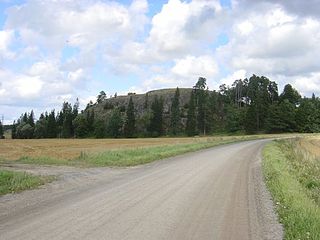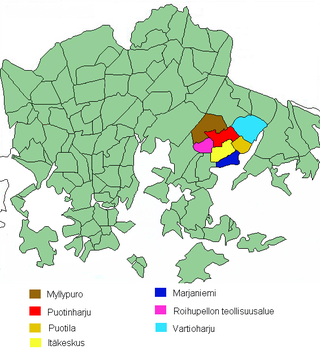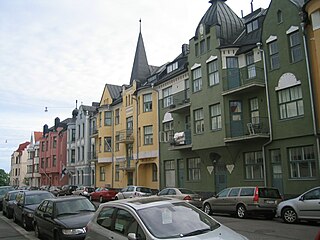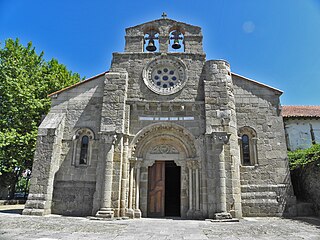
Quantico Creek is a 13.7-mile-long (22.0 km) partially tidal tributary of the Potomac River in eastern Prince William County, Virginia. Quantico Creek rises southeast of Independent Hill, flows through Prince William Forest Park and Dumfries and empties into the Potomac at Possum Point.
The Abadan Takhti Stadium is a multi-purpose stadium built in Abadan, Khuzestan province, Iran. It is currently used mostly for football matches and is the home stadium of Sanat Naft Abadan F.C. who play in the Persian Gulf Pro League. The stadium holds 10,000 people.

Old Castle of Lieto is a site of a hillfort in Lieto, Finland. It rises 55 meters above the sea level.
Vilapakkam is a panchayat town in Ranipet district in the Indian state of Tamil Nadu.
Westgate Center is a 640,000 sq ft (59,000 m2) regional outlet shopping center located in the West San Jose neighborhood of San Jose, California, United States. The mall is located at the intersection of Saratoga Avenue and Campbell Avenue. Current major anchor tenants include Burlington Coat Factory, Nordstrom Rack, Ross Dress for Less, TJ Maxx, and Target, along with Michael's, Old Navy, Gap Factory Store, and Nike Factory Store.

Hakoinen Castle is the ruins of a fortification on a hill in Janakkala, Finland. Dated to the medieval period, the fortification was situated on a very steep-sided rock by Lake Kernaala (Kernaalanjärvi) in a manner reminiscent of the hill fort tradition. The top of the rock is 63 metres (207 ft) above the water level of the lake. Today very little remains of the castle. Equally little is known about its origins.

Vartiokylä is a neighbourhood in the East Helsinki area of Helsinki, the capital of Finland. Its name is derived from the ruins of an eleventh-century fortress on the Linnanvuori hill in Vartioharju, one of Vartiokylä's subdivisions. The working population of Helsinki started building their houses in the area after the completion of Uusi Porvoontie, a road to the downtown, in the 1930s. Nowadays the area has a few high density apartment areas as well as houses. Vartiokylä became a part of Helsinki in 1946. Most of the services in the district are located in the subdivision of Itäkeskus, in the area around one of the largest shopping centers in the Nordic countries.

Lindholmen Castle was a Danish fortified castle on the banks of lake Börringe in Svedala Municipality in Scania, Sweden. The only thing left of the castle is the hill on which the castle was built and a few stones in the ground on top of the hill.

Ullanlinna is a city district of Helsinki, in Finland. The name Ullanlinna refers to the fortification line that was built at the southern edge of the area during the 18th century, as part of the town fortifications, which also included the fortress of Suomenlinna. The name Ulla refers to the Swedish Queen Ulrika Eleonora (1688–1741). During the 19th century the area was dominated by summer pavilions owned by the wealthy Helsinki middle-classes. The appearance of the area changed gradually at the end of the 19th century as the wooden houses were replaced with much higher stone buildings, designed in the prevailing Jugendstil architectural style synonymous with National Romanticism.

The Salimiyya Madrasa is a 16th-century madrasa in Damascus, Syria. It is part of the Sulaymaniyya Takiyya, started under the Ottoman sultan Süleyman I.

Tata Castle, built at the mid 14th-century on the northern tip of Lake Öreg, is one of the jewels of Tata, Hungary. Its blooming can be dated to the reign of Sigismund of Luxembourg and Mátyás Hunyadi as the summer resort of the king and a favoured residence. It was burnt by Habsburgs and later renovated. The walls of the castle reflect the marks of romantic style which is due to the Esterházy family who used to live here.

Koewarasan is a resort in Suriname, located in the Wanica District. Its population at the 2012 census was 27,713. It is located to the west of Paramaribo, and is mainly a suburban area. The municipality was founded in 1939, and was originally intended for the Javanese settlers from Java, however due to World War II, only a single group arrived. The majority of the population are East Indian. Prior to 1939, Koewarasan was an agricultural area used for the cultivation of rice.

South Carlsbad State Beach is a public beach in Carlsbad, California.

Davington Priory was a priory on the north Kent coast of England. It sits on Davington Hill, now a northern suburb of Faversham but then an isolated rural location.

The Church of Santa María de Cambre is a 12th century romanesque church in Cambre, Galicia, Spain.
Pijavice is a village in the municipality of Višegrad, Bosnia and Herzegovina.

The ancient theatre of Taormina is an ancient Greek theatre in Taormina, Sicily, built in the third century BC.

Church of the Holy Mother of God, is a church located in the town of Vagharshapat, Armenia. It was built in 1767, during the reign of Catholicos Simeon I of Yerevan, on the remains of a 16th-century wooden church. It is located at the center of modern-day Vagharshapat, around 200 meters north of the walls of the Mother See of Holy Etchmiadzin.

The Vyborg town wall was a defensive structure built around the town of Viborg. It was completed during the Swedish era in the 1470s and demolished mainly in the 1860s as Vyborg was a part of the Grand Duchy of Finland. Some minor parts of the wall are still preserved as well as two round towers.
Early fortifications of Sweden were built to defend self-governing provinces, with rapid expansion of forts in the 14th century and again later in the 16th century, when Sweden became independent and needed to protect its borders.















